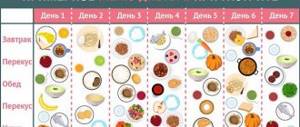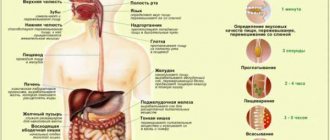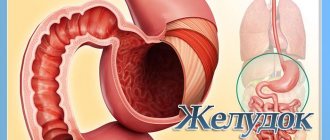In order to process consumed food, the organs of the gastrointestinal tract need a certain time. Vegetables, meat dishes, fish, seafood or fruits have different digestion rates.
When an old portion of food has not yet been fully processed, and a person adds a new one to the stomach, an excessive load is created on the internal organs, which negatively affects health. Knowing the time required for the digestive processes of each of the foods consumed will help to avoid problems with overeating and excess weight.
Digestion of food in the human stomach: how does the digestion process occur?
When putting another piece of food into their mouth, few people think about what happens to it next. The digestion process is unique; thanks to it, food is processed into microelements necessary for the normal functioning of body cells.
- The first effect on the product is exerted by the enzyme amylase, present in the saliva in the mouth.
- After swallowing, the digestive juice, which secretes special enzymes, is “engaged” in breaking down the chewed pieces. Under its influence, food breaks down into proteins, fats and carbohydrates, which move through peristalsis into the duodenum.
- Here, the resulting microelements are absorbed into the blood, with further delivery to the cells of the body.
- The small intestine separates beneficial food components from waste products. The latter move into the large intestine, where they remain for up to 20 hours, followed by excretion through the rectum.
The discipline of nutrition is based on the scientific eating of foods. Mixing foods of different durations in the stomach can provoke stagnation or fermentation, resulting in: nausea, vomiting, constipation, diarrhea, bloating. The proper functioning of the gastrointestinal tract does not disrupt natural metabolism, as a result – a healthy body and no problems with excess weight.
Helpful tips about eating
There are several rules for food consumption that promote its proper absorption:
- Try to stick to separate meals. In this case, even food with a low rate of breakdown will be absorbed faster.
- It is better not to season vegetable salads with anything. Oil or mayonnaise slow down the digestion process.
- When drinking liquid, a person dilutes gastric juice, which means it slows down its absorption. Nutritionists recommend drinking water half an hour before meals.
- Slow chewing deceives the stomach and allows you to consume a moderate amount of food, which simplifies the work of the gastrointestinal tract.
- Fiber and fermented milk products activate the intestines and prevent putrefactive processes.
- At night, internal organs should rest with the person. By filling your stomach before bed, you can ensure that you have a heaviness in your stomach the next morning. Therefore, you need to have dinner a few hours before going to bed.
- Ginger or mint added to food speeds up digestion.
The general condition of the body, as well as its mood, depends on the proper functioning of the human digestive system. In order to help your stomach, you just need to take into account the time it takes for foods to break down and follow simple rules for eating.
Time for complete digestion of food in the human stomach by product category
Anyone who is familiar with the rules of separate nutrition knows that products are conventionally divided into the following categories.
- Carbohydrates. This includes vegetables, various juices, cereals, honey, potatoes, fruits, berries. They are quickly absorbed and do not stay in the stomach for more than 1 hour. The stomach will need more time to digest complex carbohydrates – up to 3 hours. For more information about foods that are complex carbohydrates and their benefits, read the article: Complex carbohydrates.
- Protein. These are dairy products, lean meats of various types, fish, eggs, legumes. To process them, the gastrointestinal tract will have to spend 2-4 hours.
- Fatty (high in fat). They are divided into two subgroups: - vegetable: nuts, avocados, vegetable oil; - animals: fatty fish and meat, lard, butter. It takes the stomach up to 6–8 hours to digest fats.
- Partially digestible or completely indigestible. They go in “transit” through the gastrointestinal tract.
Absorption time for some foods
It can be used to determine which foods take a long time to break down in the digestive tract and which ones quickly. Water after consumption immediately enters the digestive system. If we talk about other drinks, their absorption is observed within 15-60 minutes. Dishes made from vegetables and herbs take from 30 minutes to 4 hours to digest. It all depends on the method of preparation, the presence of fiber and water. The fastest to be absorbed by the body are fresh carrots, tomatoes, cucumbers, bell peppers, lettuce, herbs and zucchini. The hardest things to process are fried potatoes, mushrooms and sauerkraut. This takes from 4 to 6 hours. Therefore, it is better not to eat them at night.
Fruit crops also do not last long. A pear, peaches, and apple pass through the stomach in 40 minutes. Citrus fruits are even easier to digest and only 20-30 minutes are enough. Bananas, mangoes and pineapples are harder to handle. But such fruits saturate the body for a long time.
Legumes can remain in the digestive tract for 2 to 3 hours. In addition to all this, they cause bloating and flatulence. Therefore, it is better to eat them as rarely as possible, and soak them before cooking.
Dried fruits and nuts can also take a long time to digest. The easiest ones to process are dates, raisins, and sunflower, pumpkin, or sesame seeds. But nuts and prunes take a little longer to digest - an average of 3 hours.
It’s not for nothing that doctors advise focusing on cereals and porridges. The residence time in the stomach does not exceed 80 minutes. The healthiest of them are rice, buckwheat, pearl barley, oatmeal, and millet.
Dairy products are not digestible by every body. Although the processing time is 2 hours, it can cause unpleasant symptoms in the form of nausea, vomiting and diarrhea. This is due to the deficiencies of a special milk enzyme. It is best to replace them with fermented milk products in the form of kefir, fermented baked milk, and natural yogurt. Their digestion time ranges from 60 to 90 minutes.
The hardest thing for the body to process is meat. This is especially true for fatty varieties such as pork, lamb, and lard. It takes at least 3.5 hours to process them. Therefore, it is recommended to replace them with lighter animal products such as chicken, beef, and turkey. They are absorbed by the stomach in about 2 hours.
Fish and seafood are quickly digested by the digestive tract. If there are low-fat types of dishes, they will be crushed within 30 minutes. Fatty fish such as trout, herring and salmon are a little more difficult to digest. This takes from 50 to 80 minutes. But shrimp and sea cocktails are absorbed by the body only after 2-3 hours.
Eggs, scrambled eggs, scrambled eggs stay in the stomach for 2 to 3 hours. Flour and confectionery products are harmful to the stomach and intestines. They contain large amounts of sugar. At least they are digested within 2 hours. But their components cause fermentation and rotting processes, thereby increasing the number of harmful bacteria.
Digestion time table for carbohydrate foods
| Vegetables | Time (hour) | Fruits | Time (hour) | Berries | Time (hour) |
| Radish | 0,4 | Persimmon | 1 | Sea buckthorn | 0,4 |
| Puree | 2 | Orange | 0,5 | Cherry | 0,4 |
| Fried potatoes | 2,5 | Grape | 1 | Strawberry | 0,3 |
| Fresh carrots | 1 | Peach | 0,4 | Currant | 0,4 |
| Eggplant | 3,5 | Apricots | 0,4 | Gooseberry | 0,5 |
| Fresh cabbage | 0,4 | Pear | 0,5 | Raspberries | 0,4 |
| Sauerkraut | 3 | Apple | 0,5 | Cherries | 0,4 |
| Cooked beets | 1 | Kiwi | 0,3 | Watermelon | 0,3 |
| Tomatoes | 0,3 | Banana | 1 | Greenery | |
| cucumbers | 0,3 | A pineapple | 1 | Lettuce leaves | 0,3 |
| Pepper | 0,4 | Mango | 2 | Onion, dill | 0,3 |
| Boiled corn | 1 | Prunes | 3 | Parsley | 0,4 |
| Melons | 0,5 | Dates | 2 | Spinach | 0,3 |
Heavy foods include mushrooms (digested in 5-6 hours) and melons (digested in up to 8 hours).
Rules for good digestion
A person prone to overeating throws different foods into his body as if it were a furnace. But firewood burns for approximately the same time, and different foods take different times to digest. Knowing how much a particular product is processed, you can intelligently approach the creation of a menu, selecting food that decomposes in approximately the same time.
Important! Proteins, fats and carbohydrates need different times to break down. Try not to eat too often, knowing that the previous portion is still in the stomach. If you add difficult-to-digest foods to your diet, your stomach will be heavy. Also, stop eating at least 4 hours before bed.
☀ It is completely unacceptable to throw foods that require different amounts of time to digest into the stomach, as if into a “furnace” - by doing this you expose it to additional and unjustified stress. For example, a dish of potatoes with pork will take about 5-6 hours to digest, while potatoes eaten separately would be digested and go to the intestines within an hour.
☀ It is optimal to mix food of the same digestion time (vegetable salad, apples with pears, carrot-beet juice) - this will only slightly extend the time the food stays in the stomach due to the difficulty of selecting enzymes for processing compared to mono-nutrition. This version of the “hodgepodge” is the most gentle for the body.
☀ Adding oils, even to salads, extends the time spent in the stomach by 2-3 times, due to the effect of enveloping food and the impossibility of its rational processing with juices and enzymes.
☀ You cannot drink water, tea and other liquids if there is undigested food in the stomach - by doing this you dilute the gastric juice, complicate the digestion of food and increase the load on the gastrointestinal tract. In addition, along with the liquid, undigested foods inevitably “slip” into the intestines, which will rot or ferment in it for a long time.
☀ If you drink water on an empty stomach, it immediately passes into the intestines.
☀ Chew your food thoroughly - this also speeds up the digestion process due to better grinding and the beginning of enzyme processing in the oral cavity.
☀ Eat protein foods only when warm - warm food is digested in the stomach for about 2-3 hours (which is the optimal time for the breakdown of proteins), and only after that it enters the small intestine, where the stage of breakdown of nutrients from food continues.
☀ Cold food in the stomach is digested much faster, so proteins do not have time to digest normally and are sent straight to the small intestine, as a result of which bacteria found in meat products (proteins) begin to multiply and cause discomfort in the gastrointestinal tract (bloating, gases, constipation).
3 principles of separate power supply
Diet for the lazy
Nutrition for sports
Don't mix food!
Nutrition during mental work
What you need to know about digestion
Diet for the lazy
How long does it take to digest fast carbohydrates, cereals and liquids?
| Liquid | Time watch) | Porridge (cereals) | Time watch) | Fast carbohydrates | Time watch) |
| Water | straightaway | Rice | 2 | Cake | 5 |
| Juice (fruit) | 0,2 | Buckwheat | 1 | Waffles | 2 |
| Vegetable smoothie | 0,2 | With millet | 1,5 | Chocolate | 2 |
| Compote | 0,3 | Corn | 1 | Cheesecakes | 3 |
| Vegetable broth | 0,3 | Pearl barley | 2 | Marmalade | 2 |
| Kvass | 0,4 | Manna | 3 | Gingerbread | 2,5 |
| Chicken bouillon | 0,4 | Oatmeal | 1 | Pasta | 3 |
| Meat broth | 1 | Gray bread | 3,5 | Honey | 1,5 |
If water is consumed on an empty stomach, it is absorbed immediately.
Features of food digestion
Taking into account the medical interpretation of the digestion process, its duration is determined by the period of time during which the food is in the stomach.
The processing process begins from the moment food is in the mouth, where it is chewed and simultaneously processed by saliva. Some substances are absorbed into the blood already at the initial stage of processing. After chewing, food enters the stomach, and its breakdown begins under the action of enzymes. The next stage - the absorption of products - occurs in the small intestine, where they also continue to be broken down. Food remains in this section of the gastrointestinal tract for 7–8 hours. After this, the remains are sent to the colon. In this place, products can linger for 20 hours.
Protein digestion time: table
| Fermented milk | Time (hour) | Meat and fish | Time (hour) | Others | Time (hour) |
| Kefir | 1 | Chick | 1,5 | Hard boiled egg | 2,5 |
| Sweet curd | 2 | Turkey | 2 | Omelette | 3 |
| Cheese | 5 | Veal | 3 | Protein | 0,3 |
| Cottage cheese whey | 1 | Duck | 3 | Yolk | 0,5 |
| Yogurt | 1,5 | Mutton | 4 | Sausages | 3 |
| Ryazhenka | 2,5 | Offal | 2,5 | Sausages | 3,5 |
| Milk | 2 | Lean pork | 5 | Beans | 3 |
| Cottage cheese | 1-1,5 | Fish | 1 | Beans | 2 |
| Brynza | 1,5 | Seafood | 2,5 | Peas | 2 |
It is not advisable to mix milk with other products. For example, tea or coffee with milk will take up to 24 hours to digest.
Product groups by digestibility time
All products can be divided into four groups according to the duration of their processing by the stomach. How long does it take to digest what we eat?
Group 1. This includes mainly carbohydrates, processing time: 30-35 minutes. These are broths, light salads, natural juices, as well as fresh (raw) vegetables and fruits.
Group 2. This category contains proteins and some fats, processing time: 1-2 hours. This group includes eggs, milk, poultry, lean fish and seafood.
Group 3. These are products containing starch and complex carbohydrates, processing time: 2-3 hours. This includes nuts, legumes, cottage cheese, hard cheese, potatoes and cereals.
Group 4. This list includes foods that take longer to digest than others or are not digested at all. This includes coffee, canned food, stewed meat, mushrooms, bread and pasta.
Time of absorption of fats in the human body: table
| Vegetable | Time (hour) | Animals | Time (hour) |
| Nuts | 3 | Lard | 6 |
| Peanut | 2,5 | Cream | 4 |
| Seeds | 2 | Butter | 5 |
Canned food is partially digested. Chewing gum passes through the gastrointestinal tract in transit.
Digestion of food in the human stomach: how and where are proteins, fats and carbohydrates absorbed?
Hydrochloric acid breaks down fruits, berries, and vegetables into carbohydrates. The acidity in the stomach is increased, and the breakdown of carbohydrates requires an alkaline pH. The main process of conversion into fructose, glucose, galactose is observed in the duodenum.
The absorption of proteins is influenced by their origin: animal or plant. Pepsin, present in hydrochloric acid, dilutes proteins as much as possible for their further transformation in the small intestine.
The stomach cannot deal with fatty foods due to the lack of special enzymes. Acid only destroys the structure of fats, turning the pieces into mush, which, if possible, breaks down into components along the way to the large intestine.
What determines the time food spends in the stomach?
When consuming culinary delights, it is important to consider that the benefits, time of absorption by the body and the release of nutrients depend on many factors. Freshness, method of preparing the additive, compatibility - everything is important and requires special attention.
The main stage of digestion of foods is carried out in the stomach and can take from 30 minutes to 6 hours, while the processing period until defecation takes approximately 20 hours.
The speed of digestion is determined by the moment when food enters the intestines; to simplify the task, consumer products must be properly systematized:
Considering the digestion time of food can significantly improve your health. Ignoring this indicator, a person carries an impressive amount of rotting products, which adversely affects health and causes diseases of the digestive system and cardiovascular system. Moreover, poor, unhealthy nutrition negatively affects life expectancy.
In order for recycling to be complete, it is important to follow simple rules:
- By simultaneously consuming foods that require different intervals for digestion, the body is subjected to excessive stress, which makes no sense. Boiled potatoes eaten on their own could enter the small intestine in an hour, when in combination with pork they are doomed to be digested for a long 6 hours.
- The best solution for preparing your favorite dishes is a combination of products that require the same amount of time to process. This will allow you to spend a little more time than with mono nutrition, but this approach is most suitable when mixing.
- When using vegetable oils as a salad dressing, it should be taken into account that the processing time in the stomach will increase several times (2-3). Oil creates a coating on vegetables, which complicates the processing of salad components by gastric juices and enzymes.
- You should not drink food immediately after eating it with teas, water, or any drinks. After a meal, it is necessary to wait until the food passes from the stomach to the intestines. If the rule is violated, the saturation of gastric juice decreases, digestion worsens and the load on the digestive system increases. Water, diluting food, prevents complete digestion; because of this, whole fragments of food penetrate into the intestines and, as a result of the active action of putrefactive microorganisms, expose undigested food to decomposition and fermentation.
- By consuming water in its pure form, without additional inclusions, it goes directly into the intestines without delay.
- Any meal does not tolerate fuss. When consuming any product, you must chew the food carefully and slowly. Thanks to this simple action, you can significantly speed up the digestion process, since the stomach will not need to expend energy on grinding ingredients, and enzyme processing occurs thoroughly in the oral cavity.
- When eating food of animal origin that is rich in protein, it is important to understand that in a heated state it is digested for 2-3 hours, then goes to the thin section to continue the breakdown of valuable components from food components.
- Less time is spent on digesting cold dishes; proteins do not have time to be absorbed and enter the small intestine, where they create favorable conditions for the proliferation of bacteria, which subsequently cause discomfort in the digestive system (gas formation, constipation). It is the consumption of cooled or chilled food that leads to the accumulation of excess weight and the acquisition of a diagnosis of obesity.
- The best time to ferment food is lunchtime. If there is a need to mix incompatible products, it is better to do this during the day. Breakfast and dinner do not fully utilize the body's reserves. In the morning he has not yet woken up, in the evening he is already ready for sleep.
- Night time is a period of rest. During this period, food lies in the stomach as dead weight until the moment of awakening. Deposits of products undergo decomposition and have a negative effect on the body.
The time it takes for food to be digested in the human stomach can be controlled. It is important to understand how quickly each product undergoes enzymatic processing.
The most popular and frequently used ingredients are presented in the table.
Consent to the processing of personal data
Privacy Policy The site takes the security of personal data seriously, so we describe in this document our view and approach to the security of personal data and how this approach applies to you, as a site visitor Who collects the information The operator who obtains your consent to the storage and processing of personal data : owner of this site Galina Ivanovna Lushanova, living at the address: 630090, Russia, Moscow. What information do we collect and why? The site is an author's blog. On the site you can subscribe to receive letters with announcements of new articles and educational newsletters, as well as send a letter to the author of the blog. When you do any of these things, we store your personal information, such as your name, email address, and in some cases, telephone number. When you sign up to receive emails announcing new articles and/or educational newsletters, we store your email address with your permission. When you send an email to the blog author, in addition to your email address, with your permission, we store your name. You allow us to save your email address and sometimes your name so that you can receive emails with announcements of new articles or lessons automatically when you click on the subscribe button in any of the subscription forms on our website, since under each of the forms there is the text: “By clicking on the button, I consent to the mailing list, the processing of personal data and agree to the privacy policy." The term of your consent is unlimited. The information that we, with your permission, have saved is used to: · Send emails announcing new articles and lessons · Answer your questions. · Conduct surveys to improve the site. · Offer new free and paid products and services. · Contact you personally via email. In addition to data forms, the site has web analytics systems Yandex Metrica, Google Analytics and Live Internet. Information from web analytics systems is collected automatically and used to improve the site Protection of personal data We are the only owners of personal data collected through forms on the site. This data will never be transferred to third parties under any conditions, unless expressly required. an authorized government body (for example, upon a written request from a court). Currently, to collect information and organize mailings, we use the services Autoweboffice, Sendpulse and Ecomtools. But, if we change the mailing list service, we will move the email address database to the new provider. This way he can access your data. The handling of personal data by third party service providers is subject to their respective privacy policies. Currently, the privacy policy of these services. Information automatically collected by web analytics systems and retargeting pixels belongs to the corresponding services and work with them is regulated by the privacy policies of these services. Disclosure to Third Parties We do not sell, trade, or transfer personal information to third parties. But! We are ready to share information to prevent crimes or assist in their investigation in cases where this is required by law. Information Security We use a variety of security measures to ensure the safety of your personal information. Servers and computers on which confidential information is recorded are in a secure environment. Use of cookies On the site, we use web analytics cookies to improve our site, as well as retargeting pixels from social networks VKontakte and Facebook to offer personalized advertising to our visitors. Unsubscribe We use email to provide you with information you request. If you would like to unsubscribe, each email contains a link where you can do so. In addition, you can always write to the address and requesting to unsubscribe from the mailing list. Your data will be deleted within 48 hours. Changes to Privacy Policy We reserve the right to change this privacy policy, so please return to this page periodically to stay informed about what information we collect and how we use it. If the changes are significant, we will send you a separate notification letter. However, we reserve the right not to notify you of changes if they are not significant. Questions and contacts If you want to change or delete your personal data, write by email or send a letter directly from the site via the feedback form Consent By subscribing or sending a message to the site administration through the support service, you automatically agree to the privacy policy.
Different characteristics of the digestive system depend on the age category of the person. While still in the mother's belly, the baby's first digestive mechanisms begin to function.
Such facts are truly unique. Typically, during life, digestion in the stomach of an adult becomes slower. But it should be noted that the direct pattern of movement of nutrients through the gastrointestinal tract is similar at all ages. How long the process of digesting food will take depends on the age category of the person, the state of the body, and the immediate characteristics of the digestive system.
What determines the duration of the food digestion process?
The time period for digestion of food in the human stomach is influenced by its condition when consumed.
- Fruits, berries, and vegetables are easily converted into carbohydrates in their raw form . Cereals must be heat treated.
- Protein foods should be eaten warm after cooking. Hot food stays in the stomach longer than cold food.
- The stomach cannot digest heavy cold food to the desired state , sending pieces to the small intestine, which provokes stagnation of undigested proteins, leading to the proliferation of bacteria, fermentation, and discomfort.
Pivot table
- 1 Summary table 1.1 Digestion time
It indicates which foods can be consumed together and which are better separately. If you follow this table and create your menu accordingly, you can lose several kilograms without dieting. After all, food that remains in the intestines for a long time creates extra stress and extra pounds are formed. When the intestines are cleansed, all harmful and stale food products leave the body. But not everyone can cleanse, and not everyone will do it. In order to avoid such a procedure and improve the health of the body, it is advisable to follow the table and combine only suitable products.
You need to know that carbohydrates are digested first, then proteins. Fats and fatty proteins take a long time to digest. For people who want to lose weight, it is useful to know that substances that are not digested are deposited in fat. Accordingly, you should eat only after the previous food has been digested. For this purpose they created something like a cheat sheet.
Food is divided into 4 categories:
- quickly digestible food;
- moderately digestible food;
- absorption takes a long time;
- absorption takes a very long time.
Digestion time
Let's take a closer look at which products belong to which category and how long it takes to digest them.
- Quickly digestible foods include juices, broths, berries, kefir, and almost all fruits. The time to digest this food is about 50 minutes.
- Food belonging to the second category includes dried fruits, vegetables, most nuts, fish, eggs, dairy products, except cottage cheese and hard cheeses. The time taken to digest this food is 1.5-2 hours as the table shows.
- Foods such as porridge, cereals, boiled beans, mushrooms, bread and baked goods, cottage cheese and hard cheeses, skinless chicken need 2–3 hours to digest.
- Drinks with milk, such as coffee, take more than 3 hours to digest in the human stomach. Pasta and canned food also require a long processing time by the stomach. And also meat, with the exception of chicken. Pork takes the longest time and effort to digest.
How to help the stomach quickly digest food: what contributes to good digestion?
If you want to help your stomach digest food, take note of the rules of good digestion:
- Food well crushed in the mouth is absorbed faster than swallowed pieces.
- Products from the same category will be digested quickly. One meal should contain food that is digested by the stomach at the same time.
- There should be at least three hours between meals.
- You should not drink water during meals, as it dilutes the acidity level, which slows down digestion. You need to drink before meals, not after.
- Milk curdles when exposed to acid. It should not be used with other products. It can clog a piece of food in a coagulated coma, which can cause food to rot.
- A productive time for peristalsis is lunch. At this meal you can eat the longest digestible foods.
How long does it take to digest and absorb different foods?
Dyspepsia is a pathological condition when the stomach does not digest food.
Such disorders can occur in both adults and children. There are many reasons for this. If no measures are taken, then serious problems with stool cannot be ruled out in the future. Food enters the intestines through the esophagus. Initially, the process of its breakdown into carbohydrates, proteins and fats occurs. What remains undigested at this moment is sent to the duodenum.
During food intake, the stomach produces acids that help separate foods into organic substances and digest them. It is also worth noting that this organ is equipped with walls that protect the stomach from the effects of produced acids.
The duration of the food processing process in the body varies from 15 minutes to 7-8 hours. In many ways, the timing depends on the processing characteristics, calorie content and composition of the food consumed.
The following symptoms indicate that food is poorly digested:
- feeling of a full stomach;
- the stomach is swollen, it feels full;
- nausea, vomiting;
- belching and heartburn;
- after eating is finished, a burning sensation appears in the chest area;
- heaviness and pain localized in the upper abdomen;
- in the stool it is noticeable that food comes out in pieces;
- pain localized in the upper spine;
- satiety occurs too quickly, problems with appetite appear.
The most common reasons that lead to food not being digested lie in an incorrectly selected diet and non-compliance with the diet. Eating dry food, frequent snacks on the run - all this negatively affects the state of the gastrointestinal tract.
In addition, there are a number of foods that the body is not able to perceive and therefore rejects them. For this reason, there is stagnation in the intestines.
In addition, similar changes are observed in the following cases:
- metabolism is slow;
- pathogenic microorganisms are present in the mucous membranes of the organ;
- the secretion of gastric juice is insufficient;
- frequent consumption of alcoholic beverages;
- a history of gastrointestinal pathologies.
Doctors also note cases when such disorders are provoked by hormonal imbalance. If a feeling of heaviness in the intestines appears in the morning, then most likely the person has a habit of eating at night.
The physiological reason that food is not digested and you feel sick after eating is the body’s protective reaction to a negative impact. If such violations are observed systematically, then medical consultation is needed.
The following factors can provoke the appearance of such symptoms:
- overheat;
- motion sickness when eating in transport;
- poisoning from tobacco smoke or other impurities present in the air;
- poor ventilation in the room and lack of oxygen as a result;
- allergic reaction to odors or medications;
- food poisoning and intoxication;
- excessive overeating.
As a rule, accompanying symptoms are observed:
- the pulse becomes rapid;
- there is a pronounced pain syndrome;
- paleness of the skin appears;
- noticeable excessive sweating;
- there is copious secretion of saliva;
- an uncharacteristic taste appears in the mouth;
- the chill makes itself known.
A number of other clinical manifestations may also appear.
Such symptoms most often occur for the following reasons:
- fried, hot, spicy and fatty foods are often consumed, the wrong diet is chosen;
- excessive overeating occurs;
- there is abuse of fast food;
- eating is not according to the schedule;
- irritable bowel syndrome is observed;
- there is exposure to stress;
- Humans have various gastrointestinal pathologies.
Diarrhea, in which foods are not completely digested, can occur for several reasons. Some of them can be easily eliminated, while others will require long-term treatment.
Among the most common factors causing problems are the following:
- the volume of food consumed is quite large;
- food is excessively fatty;
- products that are consumed at the same time differ in composition and consistency;
- disruptions in the production of enzymes;
- a large amount of fiber in the menu;
- stress;
- taking medications that suppress the activity of enzyme systems;
- peristalsis is accelerated;
- dysbacteriosis;
- gastrointestinal diseases.
There are also risk groups. Certain people are predisposed to the appearance of such a pathological condition. Among them are infants whose digestive system is not yet fully formed and the elderly. Symptoms also appear in the presence of internal pathologies.
Indigestion is often observed during pregnancy. Such disorders appear as a result of hormonal fluctuations, exacerbation of gastritis and the penetration of pathogenic bacteria into the intestinal mucosa.
If the pathological condition has developed due to hormonal changes and gastrointestinal pathologies are excluded, then the woman is advised to reconsider her diet.
If the products are combined correctly, the absorption of food will be complete.
In the case when the diet is organized correctly, but for a long time the stomach refuses to work fully, then you cannot do without medical help.
Such changes most likely arose due to the development of pathologies. In the absence of proper therapy, such disorders can negatively affect the condition of the fetus.
First of all, the doctor collects an anamnesis. You need to tell the doctor in every detail about when the disorders appeared, how pronounced the pain syndrome is, when it manifests itself, whether heartburn appears and whether other gastrointestinal diseases are present.
At the next stage, a number of laboratory and instrumental diagnostic measures are prescribed.
Among the instrumental ones, ultrasound and CT can be distinguished.
In addition, electrogastroenterography is also performed to identify intestinal motility disorders. If there is a suspicion of tumor growth, radiography is performed. Analysis of the surface of the organ is done using an endoscope.
A biopsy is performed quite often. You also need to do tests for the presence of Helicobacter pylori bacteria in the body.
Stool and blood tests are performed in the laboratory.
Treatment is usually carried out comprehensively. First of all, medications are prescribed. Traditional medicine recipes can be used as aids. Proper diet and exercise are important.
If such disorders are provoked by concomitant pathologies, then first of all they resort to eliminating them. Treatment of dyspepsia itself is carried out using various groups of medications.
The main clinical manifestations can be eliminated using the following components:
- Enzymatic. Helps improve the digestion process, as well as the functioning of the duodenum and stomach.
- Proton pump blockers. They are used in case of increased acidity, heartburn and sour belching.
- Histamine blockers. They reduce acidity, but have only a weak effect.
- Antispasmodics. Painkillers that relieve pain.
Folk remedies will help cope with dyspepsia.
The most commonly used are the following:
- Infusion based on celery. A teaspoon of crushed roots is poured into a liter of boiling water and left for eight hours. Take a decoction of 50 ml throughout the day. The interval between doses is 1 hour.
- Eucalyptus infusion. Dried leaves of the plant are poured into 0.5 liters of boiling water and left until the liquid cools completely. Take 50 ml orally three times a day.
- Mint decoction. About 50 grams of mint is poured into a glass of boiling water and infused. Take half a glass of decoction at intervals of four hours.
- Camomile tea. The medicinal plant in the amount of two tablespoons is poured into 200 ml of boiling water and infused. The finished product is filtered and drunk 50 ml during periods of exacerbation.
Nutritional Features
Diet is of no small importance in the process of restoring stomach activity. It is extremely important to exclude from the diet foods containing coarse fiber, as well as alcoholic, carbonated drinks and fatty meats.
You must also adhere to the following rules:
- food should be chewed with special care;
- portions should be small;
- For the full production of gastric juice, it is extremely important that the food looks appetizing;
- do not drink before or after meals;
- Drink no more than a glass of liquid in an hour and a half;
- do not eat near the TV;
- use separate nutrition (carbohydrates and proteins must enter the body separately).
The following set of exercises will help cope with the problem:
- While lying on your back, you need to clasp your lower limbs with your hands and pull them towards your stomach. In this position, sway, slightly rounding your back.
- Lying on the floor, try to reach the floor near your head with your feet.
- Massage your stomach with light movements for five minutes.
Complications
If the problem is not treated in a timely manner, then there is a risk of developing serious gastropathologies.
In this case, not only the stomach, but also the gallbladder, liver, and pancreas are involved in the pathological process. Therapy in this case will be quite long.
Avoiding the development of dyspepsia is quite simple.
To do this, you just need to adhere to the following recommendations:
- minimize the consumption of fatty, spicy and spicy foods;
- salt foods very little;
- do not resort to strict diets;
- include a large amount of fruits and vegetables in your diet;
- avoid stressful situations;
- systematically undergo examination of the gastrointestinal tract;
- give up bad habits.
Dyspepsia is a common and quite serious problem, the elimination of which often requires complex therapy.
It is strictly forbidden to ignore this condition. If left untreated, there is a risk of serious complications that may be difficult to resolve.
Everyone is familiar with the function of the stomach - it is created in order to contain consumed foods and digest them, extracting the vitamins and minerals necessary for the body.
When the diet is disrupted and the quality of the food leaves much to be desired, the body malfunctions and the stomach does not digest food well or stops altogether.











